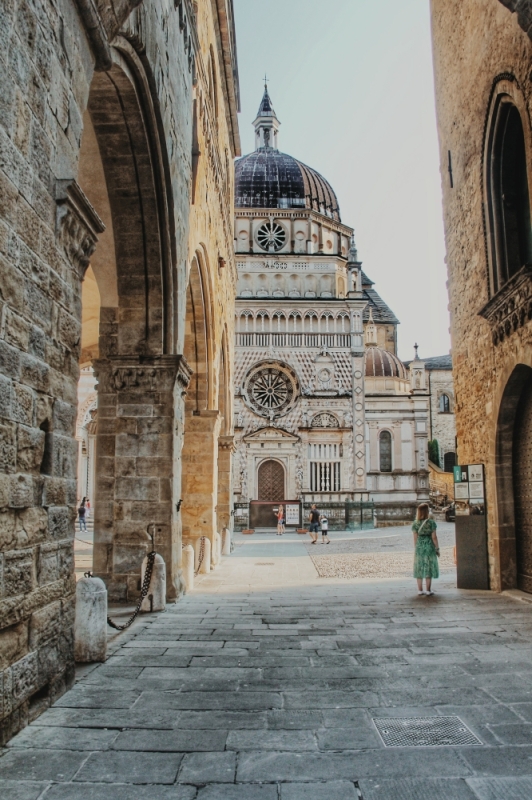The Historic and Fascinating Bergamo
The two cities of Bergamo and Brescia, twinned together for the occasion, have been named capitals of Italian culture for the year 2023. Just a few kilometers away from each other and located in the northern part of Lombardy, they won among others because they are rich in history, exceptional architecture and precious cultural traditions.
Bergamo, divided between the Upper city and the Lower city, the Upper part is a popular tourist destination, famous for its village, its narrow streets and its stone buildings, as well as for its numerous museums, including the Bergamo Civic Museum and the Gallery of Modern and Contemporary Art. This part of the city is fortified through the Venetian walls dating back to the 16th century. This wall is made up of 14 bulwarks, 2 floors, 32 sentry boxes, 100 openings for guns, two powder magazines, 4 doors and has been listed since 2017 among the world heritage sites protected by UNESCO. The upper part is connected to the lower city via a beautiful and evocative funicular which I absolutely recommend taking.
Bergamo was founded already in pre-Roman times by the Celtic people and already during the Roman period, starting from 49 BC, it became a fortified and important city. After the fall of the Roman Empire it was governed by the Lombards, then by the Viscontis of Milan until it was under the influence of the Republic of Venice starting from 1428. Then passing under the government of various Republics, since 1860 Bergamo has been part of the Kingdom of 'Italy and then of the Italian Republic. In the 19th century, it became an industrial and commercial center attracting immigrants. In the 20th century, it continued to develop as an industrial and cultural center. Today Bergamo is a vibrant city with a rich cultural history, attractive to tourists for its architectural beauty.
The Unmissable Attractions of Bergamo
In Bergamo there is so much to see among the various museums, historical buildings, churches, botanical gardens, but a walk through the medieval village of the upper part and then going down towards the lower part along stairways and narrow streets would be enough to fall in love with this city. But in particular we advise you to see in the upper part:
- Piazza Vecchia, with the ancient Contarini fountain, the Palazzo della Ragione and the civic tower (called the Campanone)
- The UNESCO World Heritage walls from which you can admire a breathtaking view of the city below
- The cathedral of Sant'Alessandro with the beautiful Colleoni chapel by the architect Giovanni Antonio Amadeo and the baptistery built by Giovanni da Campion
- Basilica of Santa Maria Maggiore: a Gothic church with an imposing white marble facade and sumptuous interior decoration.
Instead, in the Lower Bergamo part we point out:
Bergamo Civic Museum which houses a vast collection of art and historical artefacts including paintings, sculptures and Egyptian art and the Donizetti Theater built in the 19th century known for its excellent acoustics and its neoclassical architecture.
- Piazza Vecchia, with the ancient Contarini fountain, the Palazzo della Ragione and the civic tower (called the Campanone)
- The UNESCO World Heritage walls from which you can admire a breathtaking view of the city below
- The cathedral of Sant'Alessandro with the beautiful Colleoni chapel by the architect Giovanni Antonio Amadeo and the baptistery built by Giovanni da Campion
- Basilica of Santa Maria Maggiore: a Gothic church with an imposing white marble facade and sumptuous interior decoration.
Instead, in the Lower Bergamo part we point out:
Bergamo Civic Museum which houses a vast collection of art and historical artefacts including paintings, sculptures and Egyptian art and the Donizetti Theater built in the 19th century known for its excellent acoustics and its neoclassical architecture.
Instead, in the Lower Bergamo part we point out:
- Bergamo Civic Museum which houses a vast collection of art and historical artefacts
- Bergamo Civic Museum which houses a vast collection of art and historical artefacts
- the Donizetti Theater built in the 19th century known for its excellent acoustics and its neoclassical architecture.
Brescia: A Journey Between History and Art
Instead Brescia, located south of Bergamo, was founded over 3,200 years ago. It is known for its artistic and architectural heritage: its monuments from the Roman and Lombard periods have been declared a World Heritage Site by UNESCO. Founded around 1,200 BC. C. by the Ligurians, then conquered by the Gauls, around the 3rd/2nd century it passed under the Roman Empire. Once the Empire fell it was the destination of numerous barbarian invasions including the Visigoths and Attila's Huns, and then passed under the Lombards starting from 568. It was under the Visconti domination and then under the Republic, and then finally, through several other conquests, being annexed to the Kingdom of Italy in 1860. Today also famous for the Mille Miglia vintage car race, which starts and finishes in this town, it is also the capital for the production of the famous Franciacorta wine. Active in the manufacturing, metalworking, textile, chemical and food industries, it is one of the main economic-productive centers in Italy. Brescia offers a wide range of cultural attractions, such as the Santa Giulia Museum and the Tosio Martinengo Art Gallery.
Given its long history Brescia has so much to offer tourists who visit it, the city itself is an archaeological site which houses important remains of the ancient Roman city. Not to be missed:
- The monumental area of the Roman Forum with the oldest building the "republican sanctuary", with its temple called "capitolium" and the Roman theater built in the Flavian era.
- Monumental complex of San Salvatore and Santa Giulia with its Museum of Santa Giulia: a museum that explores the history of the city through a vast collection of artefacts, including paintings, sculptures and ceramics.
- Brescia Castle: a medieval castle, now a public park, allows visitors to walk among the ancient defense structures and enjoy a wonderful view of the city, as well as the possibility of visiting the two museums housed here.
- Piazza della Loggia and Palazzo della Loggia: a central Renaissance square with the monumental Palazzo della Loggia, seat of the municipal council, built starting from 1492 under the direction of Filippo Grassi, completed in the sixteenth century by Sansovino and Palladio, but with a stupendous hall built in the eighteenth century by the architect Luigi Vanvitelli.
- Pinacoteca Tosio Martinengo: a vast art gallery, housed in the historic center in the Martinengo da Barco palace, exhibits works ranging from Gothic and late Gothic of the full fourteenth and fifteenth centuries, up to nineteenth-century and Romantic works by Francesco Hayez, Antonio Canova, Romanino, Moretto, Giovanni Gerolamo Savoldo, up to the section dedicated to the eighteenth-century painting of Giacomo Ceruti, known as Pitocchetto.
- Monumental complex of San Salvatore and Santa Giulia with its Museum of Santa Giulia: a museum that explores the history of the city through a vast collection of artefacts, including paintings, sculptures and ceramics.
- Brescia Castle: a medieval castle, now a public park, allows visitors to walk among the ancient defense structures and enjoy a wonderful view of the city, as well as the possibility of visiting the two museums housed here.
- Piazza della Loggia and Palazzo della Loggia: a central Renaissance square with the monumental Palazzo della Loggia, seat of the municipal council, built starting from 1492 under the direction of Filippo Grassi, completed in the sixteenth century by Sansovino and Palladio, but with a stupendous hall built in the eighteenth century by the architect Luigi Vanvitelli.
- Pinacoteca Tosio Martinengo: a vast art gallery, housed in the historic center in the Martinengo da Barco palace, exhibits works ranging from Gothic and late Gothic of the full fourteenth and fifteenth centuries, up to nineteenth-century and Romantic works by Francesco Hayez, Antonio Canova, Romanino, Moretto, Giovanni Gerolamo Savoldo, up to the section dedicated to the eighteenth-century painting of Giacomo Ceruti, known as Pitocchetto.
The Culinary Tradition of Bergamo and Brescia
We are in Italy and as in the rest of the country, Lombard cuisine, of which Bergamo and Brescia are part, is known for its quality and variety of flavours. Absolutely worth tasting in Bergamo are Polenta taragna (polenta-based dish served with cheese and melted butter), Casoncelli (type of filled pasta similar to tortelli, usually served with butter and sage) and Polenta e Osei (dessert in the shape of dome based on sweet polenta, almond paste and dark chocolate).
In Brescia, however, you can taste Bigoi with Pestöm (a particularly tasty first course of pasta prepared with large spaghettoni and seasoned with coarsely chopped fresh salami mixture), Rabbit Bresciana style (cooked with butter, lard and Lugana wine which makes the rabbit meat tender and particularly tasty) accompanied by a tasty Polenta and for dessert Castagnaccio (a traditional poor dessert prepared with chestnut flour and enriched with raisins, pine nuts and rosemary).
In Brescia, however, you can taste Bigoi with Pestöm (a particularly tasty first course of pasta prepared with large spaghettoni and seasoned with coarsely chopped fresh salami mixture), Rabbit Bresciana style (cooked with butter, lard and Lugana wine which makes the rabbit meat tender and particularly tasty) accompanied by a tasty Polenta and for dessert Castagnaccio (a traditional poor dessert prepared with chestnut flour and enriched with raisins, pine nuts and rosemary).
These are just some of the many cultural attractions that Bergamo and Brescia have to offer. As Capitals of Culture 2023, both cities have planned a series of events and activities to celebrate their rich cultural heritage, including art exhibitions, theater performances and concerts. Don't miss the opportunity to visit Bergamo and Brescia in this special year by booking on https://www.MeTour.it








